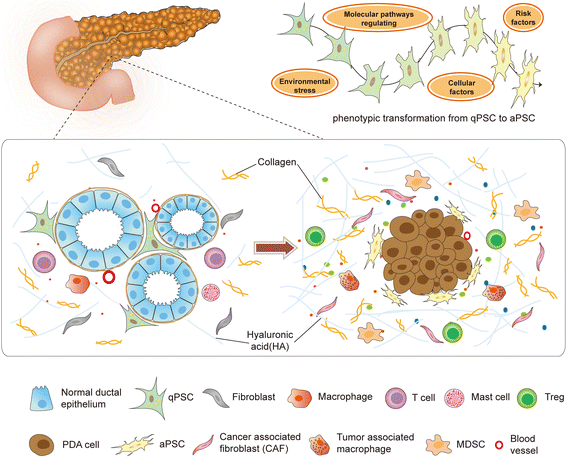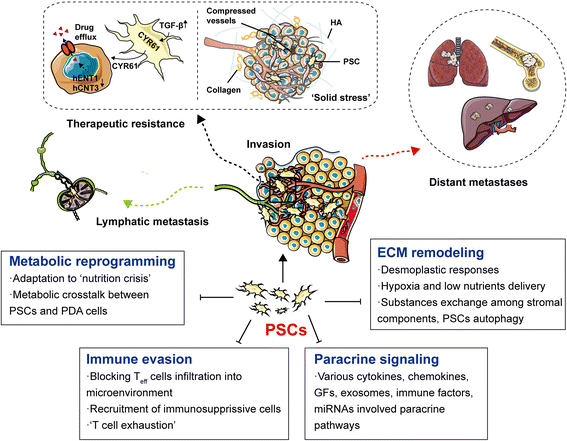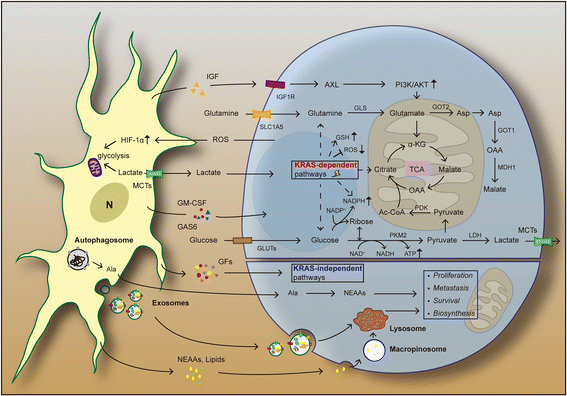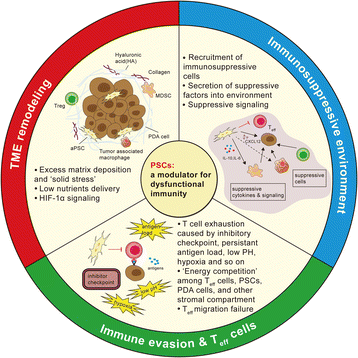The critical roles of activated stellate cells-mediated paracrine signaling, metabolism and onco-immunology in pancreatic ductal adenocarcinoma
- PMID: 29458370
- PMCID: PMC5817854
- DOI: 10.1186/s12943-018-0815-z
The critical roles of activated stellate cells-mediated paracrine signaling, metabolism and onco-immunology in pancreatic ductal adenocarcinoma
Abstract
Pancreatic ductal adenocarcinoma (PDAC) is one of the most lethal malignant diseases worldwide. It is refractory to conventional treatments, and consequently has a documented 5-year survival rate as low as 7%. Increasing evidence indicates that activated pancreatic stellate cells (PSCs), one of the stromal components in tumor microenvironment (TME), play a crucial part in the desmoplasia, carcinogenesis, aggressiveness, metastasis associated with PDAC. Despite the current understanding of PSCs as a "partner in crime" to PDAC, detailed regulatory roles of PSCs and related microenvironment remain obscure. In addition to multiple paracrine signaling pathways, recent research has confirmed that PSCs-mediated tumor microenvironment may influence behaviors of PDAC via diverse mechanisms, such as rewiring metabolic networks, suppressing immune responses. These new activities are closely linked with treatment and prognosis of PDAC. In this review, we discuss the recent advances regarding new functions of activated PSCs, including PSCs-cancer cells interaction, mechanisms involved in immunosuppressive regulation, and metabolic reprogramming. It's clear that these updated experimental or clinical studies of PSCs may provide a promising approach for PDAC treatment in the near future.
Keywords: Drug resistance; Immune evasion; Metabolic reprogramming; PDAC; Pancreatic stellate cells.
Conflict of interest statement
Ethics approval and consent to participate
Not applicable.
Consent for publication
Not applicable.
Competing interests
The authors declare that they have no competing interests.
Publisher’s Note
Springer Nature remains neutral with regard to jurisdictional claims in published maps and institutional affiliations.
Figures




Similar articles
-
Persistent activation of pancreatic stellate cells creates a microenvironment favorable for the malignant behavior of pancreatic ductal adenocarcinoma.Int J Cancer. 2013 Mar 1;132(5):993-1003. doi: 10.1002/ijc.27715. Epub 2012 Oct 5. Int J Cancer. 2013. PMID: 22777597 Review.
-
The role of S100A9 in the interaction between pancreatic ductal adenocarcinoma cells and stromal cells.Cancer Immunol Immunother. 2022 Mar;71(3):705-718. doi: 10.1007/s00262-021-03026-y. Epub 2021 Aug 10. Cancer Immunol Immunother. 2022. PMID: 34374812 Free PMC article.
-
Global targetome analysis reveals critical role of miR-29a in pancreatic stellate cell mediated regulation of PDAC tumor microenvironment.BMC Cancer. 2020 Jul 13;20(1):651. doi: 10.1186/s12885-020-07135-2. BMC Cancer. 2020. PMID: 32660466 Free PMC article.
-
Galectin-3 Mediates Tumor Cell-Stroma Interactions by Activating Pancreatic Stellate Cells to Produce Cytokines via Integrin Signaling.Gastroenterology. 2018 Apr;154(5):1524-1537.e6. doi: 10.1053/j.gastro.2017.12.014. Epub 2017 Dec 21. Gastroenterology. 2018. PMID: 29274868
-
Fibrotic Fortresses and Therapeutic Frontiers: Pancreatic Stellate Cells and the Extracellular Matrix in Pancreatic Cancer.Cancer Med. 2025 Jun;14(11):e70788. doi: 10.1002/cam4.70788. Cancer Med. 2025. PMID: 40437741 Free PMC article. Review.
Cited by
-
Pancreatic Stellate Cells and the Targeted Therapeutic Strategies in Chronic Pancreatitis.Molecules. 2023 Jul 22;28(14):5586. doi: 10.3390/molecules28145586. Molecules. 2023. PMID: 37513458 Free PMC article. Review.
-
Pancreatic Cancer and Cellular Senescence: Tumor Microenvironment under the Spotlight.Int J Mol Sci. 2021 Dec 27;23(1):254. doi: 10.3390/ijms23010254. Int J Mol Sci. 2021. PMID: 35008679 Free PMC article. Review.
-
Application of Mass Spectrometry in Pancreatic Cancer Translational Research.Front Oncol. 2021 Oct 11;11:667427. doi: 10.3389/fonc.2021.667427. eCollection 2021. Front Oncol. 2021. PMID: 34707986 Free PMC article. Review.
-
Enhancing the Efficacy of CAR T Cells in the Tumor Microenvironment of Pancreatic Cancer.Cancers (Basel). 2020 May 28;12(6):1389. doi: 10.3390/cancers12061389. Cancers (Basel). 2020. PMID: 32481570 Free PMC article. Review.
-
Overcoming the Tumor Microenvironmental Barriers of Pancreatic Ductal Adenocarcinomas for Achieving Better Treatment Outcomes.Adv Ther (Weinh). 2021 Jun;4(6):2000262. doi: 10.1002/adtp.202000262. Epub 2021 Apr 24. Adv Ther (Weinh). 2021. PMID: 34212073 Free PMC article.
References
-
- Ryan DP, Hong TS, Bardeesy N. Pancreatic adenocarcinoma. N Engl J Med. 2014;371:2140–2141. - PubMed
-
- Muckenhuber A, Berger AK, Schlitter AM, Steiger K, Konukiewitz B, Trumpp A, Eils R, Werner J, Friess H, Esposito I, et al: Pancreatic Ductal Adenocarcinoma Subtyping using the Biomarkers Hepatocyte Nuclear Factor-1A and Cytokeratin-81 Correlates with Outcome and Treatment Response. Clin Cancer Res 2017. 10.1158/1078-0432.CCR-17-2180. [Epub ahead of print] - PubMed
-
- Siegel RL, Miller KD, Jemal A. Cancer Statistics, 2017. CA Cancer J Clin. 2017;67:7–30. - PubMed
Publication types
MeSH terms
Substances
LinkOut - more resources
Full Text Sources
Other Literature Sources
Medical

